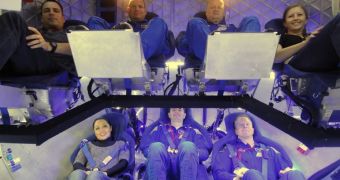A manned version of the Dragon space capsule, which is being developed by Hawthorne, California-based Space Exploration Technologies Corporation (SpaceX), has just passed an important review.
The vehicle is meant to allow NASA astronauts access to targets in low-Earth orbit, including the International Space Station, aboard American-built vehicles. At this point, the space agency is relying on the Russian Federal Space Agency (RosCosmos) for access to orbit.
SpaceX is also developing an unmanned version of the Dragon, which it already launched to space on December 10. A new flight is scheduled for May 19. During this mission, the vehicle will attempt to dock to the ISS, the first time ever when a private spacecraft is allowed to do so.
The corporation is conducting these efforts under a $1.6 billion Commercial Orbital Transportation Services (COTS) contract, for the unmanned Dragon, and a Commercial Crew Development Round 2 (CCDev2) contract, for the manned version of the spacecraft.
“I am very pleased with the progress SpaceX and our other commercial partners are making during the CCDev2 effort,” says Philip McAlister, who is the Commercial Spaceflight Director at NASA.
“Together with NASA’s development of beyond low Earth orbit systems, commercial crew and cargo transportation is an integral part of our overall human spaceflight program,” he goes on to say.
The new tests the Dragon was put through were meant to assess whether the layout SpaceX selected for the manned capsule enables astronauts to move freely and efficiently within the vehicle. The review lasted for two days, and was carried out by NASA engineers and veteran space shuttle astronauts.
The vehicle model contained most interior systems that will go on the actual spacecraft, including lighting, environmental control, life support systems, displays, controls, seats, cargo racks and so on.
“This milestone demonstrated the layout of the crew cabin supports critical tasks. It also demonstrated the Dragon interior has been designed to maximize the ability of the seven-member crew to do their job as effectively as possible,” says SpaceX Commercial Crew Development manager, Garrett Reisman.
In addition to performing reach and visibility evaluations, the astronauts and engineers also entered and exited the spacecraft under both normal and emergency conditions. The manned Dragon passed all tests with flying colors.
“As an anchor customer for commercial transportation services, we are happy to provide SpaceX with knowledge and lessons learned from our 50 years of human spaceflight,” explains Ed Mango, who is the Commercial Crew Program Manager at NASA.
“We appreciate the opportunity SpaceX gave us to provide feedback on these critical interior systems while the company maintains its flexibility to appeal to other customers,” the official concludes.

 14 DAY TRIAL //
14 DAY TRIAL //